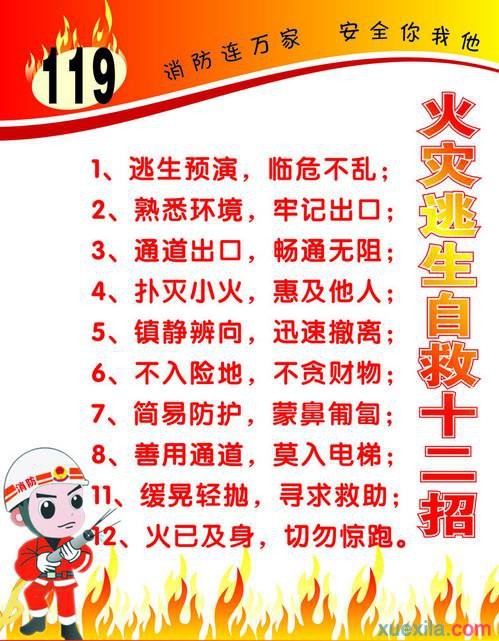解决方案
|
How to escape in case of fireOnce a fire breaks out, surrounded by thick smoke, toxic gas, and flames, many people die in the sea of fire, while others narrowly escape death. So, how should one escape in the event of a fire? What are the methods for fire escape and self rescue?
Methods for escape and self rescue in case of fire 1. If the clothes on the body cause a fire due to static electricity or careless smoking, the clothes should be quickly taken off or torn off, or rolled over to extinguish the fire, but be careful not to roll too fast. Never run while wearing clothes that are on fire. If there is water, it can be quickly extinguished with water, but when the human body is burned, it must not be watered to prevent infection. 2. If dormitories, classrooms, laboratories, hotels, restaurants, bathhouses, etc. catch fire, the following methods can be used to escape: (1) The method of using towels or handkerchiefs to cover the nose and mouth during evacuation is recommended due to the high temperature, high toxicity, low oxygen content, and high carbon monoxide content of the smoke in the fire scene. Inhalation can easily cause respiratory burns or nerve poisoning. Therefore, wet towels or handkerchiefs should be used to cover the mouth and nose during evacuation (but the thickness of hair towels and handkerchiefs should not exceed six layers). Attention: Do not evacuate with the wind, quickly flee to the upwind area to avoid the invasion of fireworks. Due to the characteristic of too much smoke gathering in the upper space during a fire, spreading quickly upwards and slowly laterally, it is not advisable to walk upright during evacuation. Instead, one should bend down or crawl forward. However, in the event of a liquefied petroleum gas or city gas fire, crawling forward should not be used. (2) Cover and protect oneself. Cover yourself with a damp cotton coat, cotton quilt, door curtain, blanket, burlap bag, etc. After determining the escape route, rush out of the fire as quickly as possible and reach a safe location. However, be careful to cover your nose and mouth to prevent carbon monoxide poisoning. (3) Isolation method. If the fire in the hallway, across the door, or next door is too strong to evacuate, you can retreat into a room and seal the door gap with a towel, blanket, cotton quilt, mattress, or other fabric to prevent heat. You can continuously water it upwards to cool it down. To prevent external flames and smoke from entering, thereby achieving the goal of suppressing the spread of fire and prolonging its duration. (4) Toilet Evacuation Law. When a fire occurs and there is no way to escape, one can use the bathroom for shelter. Due to the high humidity and low temperature in the bathroom, water can be poured on the door or floor to cool down. Water can also be sprayed from the door crack towards the outside to achieve the purpose of cooling down or controlling the spread of fire. (5) Multi story building fire escape method. If a multi story building catches fire and the smoke from the stairs is particularly intense, one can use the balcony, water slide, or canopy of the house to escape. Alternatively, ropes, fire hoses, or torn sheets can be used to connect instead. However, one end should be securely tied to the pipe of the heating system or the hook of the radiator, as well as to doors, windows, or other heavy objects, and then slid down along the rope. (6) Forced jumping off a building to escape. If the above self rescue methods are unconditionally adopted and time is extremely tight, the threat of fireworks is severe, and one is forced to jump off a building, this method can be used to escape from lower floors. However, first throw some thick cotton quilts and sofa cushions onto the ground to increase cushioning, then slide down the window sill with your hands to reduce the height of the jump and ensure that both feet land first. 3. When a fire breaks out, you can call out loudly from windows, balconies, shaded areas, rooftops, rooftops, or refuge areas, tapping metal objects, throwing soft and fine objects, and using flashlights, lighters, and other objects at night to emit a distress signal. Raise the attention of rescue personnel and buy time for escape. Principles for escaping from a fire scene *The principle of fire escape is to combine safe evacuation with rescue. Safe evacuation refers to personnel in the fire scene seizing favorable opportunities, being nearby and convenient, using all available terrain and tools to quickly evacuate the dangerous area. The combination of rescue is a combination of self rescue and mutual rescue. At the scene of a fire, we not only need to evacuate the scene as soon as possible, but also actively help the elderly, the weak, the sick, the disabled, women, children, etc. to evacuate. We must not act recklessly, otherwise it will block the passage and cause a big disaster; The second is to combine escape with emergency rescue. Sometimes fires can be unpredictable, and if the danger is not eliminated in a timely manner, it may cause more casualties. Therefore, when conditions permit, every effort should be made to eliminate dangerous situations, delay the occurrence of fires, and reduce the scale of disasters; The third is to combine rescuing people with rescuing objects. In all situations, saving people is always the top priority, and never miss the opportunity to escape by rescuing personal valuables. Selection of escape routes in case of fire The paths that people tend to choose when escaping from a fire generally have the following tendencies: (1) Retribution: Escape towards the place you are most familiar with. (2) Daily Habitual: Escaping through the most commonly used stairs or exits in daily life (3) Openness: It means escaping towards an open or spacious direction. (4) Proximity: Escape in the direction of * entering the line of sight or the nearest direction. (5) Instinctively avoiding danger: instinctively moving away from the direction of fire and smoke. (6) Blind obedience: Following the direction of most people's escape. (7) Self perceived safety directionality: that is, escaping towards the path one considers safe, such as jumping off a low floor. (8) Rational analysis: It means being able to calmly analyze risks, have a moderate approach, have evidence for up and down, and evacuate safely. Precautions for fire escape and self rescue Of course, the most advisable way to avoid the various evacuation tendencies mentioned above is through rational analysis. However, in order to achieve fearlessness and composure in the face of disasters, in addition to having high-quality psychological resilience, it is also necessary to be familiar with and master the following 3 to 5 items. 1. Familiar with the environment We should develop the habit of being familiar with the structure of familiar or unfamiliar environments. For example, for long-term families, workplaces, hotels and restaurants, theaters, especially large public places, it is necessary to determine the location of their exits, as well as the location of doors, windows, skylights, balconies, etc. Secondly, pay attention to the location of emergency exits, shelters, and safety exits, as well as the location of alarms and fire extinguishers. Items that may be used as escape equipment such as bed sheets, towels, duvet covers, curtains, etc. Only in this way can we be well prepared, and in the event of a fire, we may be able to escape the scene smoothly and save our lives. 2. Take immediate smoke prevention measures When feeling smoke or fire irritation, smoke prevention measures should be taken regardless of whether there is smoke nearby. The commonly used smoke prevention measure is to cover the mouth and nose with dry or wet towels. If a dry towel is used, the more layers it is folded, the better the smoke removal effect. Using a damp towel for smoke removal is more effective, and the wetter the towel, the better the effect. But if the towel is too wet, it can easily cause difficulty breathing. When the moisture content of the towel is 1.5-2.5 times its own weight, the weaving thread of the towel becomes thinner due to moisture, and the gaps increase, resulting in a worse smoke removal effect than dry towels. When using a towel to cover your mouth and nose, be sure to increase the area of smoke filtering as much as possible. Make sure to cover your mouth and nose tightly. Even if you feel an increase in breathing resistance when passing through the smoke area, you cannot remove the towel, as it may cause poisoning if removed. 3. When evacuating from a fire scene, one must remain calm and composed, overcome panic, self suggestion, and eliminate nervousness. Then you can cover your mouth and nose with a towel and choose a feasible escape route. Before opening frequently used doors, windows, corridors, stairs, emergency doors, exits, etc., it is necessary to first feel whether the door or window is heating up. If it is already heating up, it cannot be opened and immediately change course and choose another path. 4. When escaping, do not retreat to narrow corners such as under the bed, corners of the wall, under the table, or in the wardrobe. When passing through thick smoke areas, try to move forward quickly in a * or crawling position as much as possible, and cover your mouth and nose with a wet towel. Be careful to close the doors and windows on the passage at will to prevent and delay the smoke from tracking and flowing towards the escaping passage. If your clothes catch fire, you should quickly remove them, roll them on the spot, and extinguish the fire. Be careful not to roll too fast, and do not run in clothing that is on fire. If there is a nearby pool, jump into the water quickly. 5. Do not easily take ordinary elevators on the fire scene. Due to *, power outages often occur during fires, causing elevator "jamming" and increasing the difficulty of rescue work; Secondly, the elevator entrance leads directly to each floor of the building, and smoke flowing into the elevator passage can easily form a "chimney effect". People inside the elevator can be suffocated by thick smoke and toxic gases at any time. 6. If it's not hot, you can only carefully open it a little and quickly pass through it, then quickly close it. When it is really difficult to distinguish the direction, one should first evacuate in the direction away from the fireworks, and try not to evacuate upstairs. When evacuating, one should establish the idea that time is life and escape. Evacuation should be quick, the faster the action, the better. Do not delay time due to searching or moving certain items.
|


